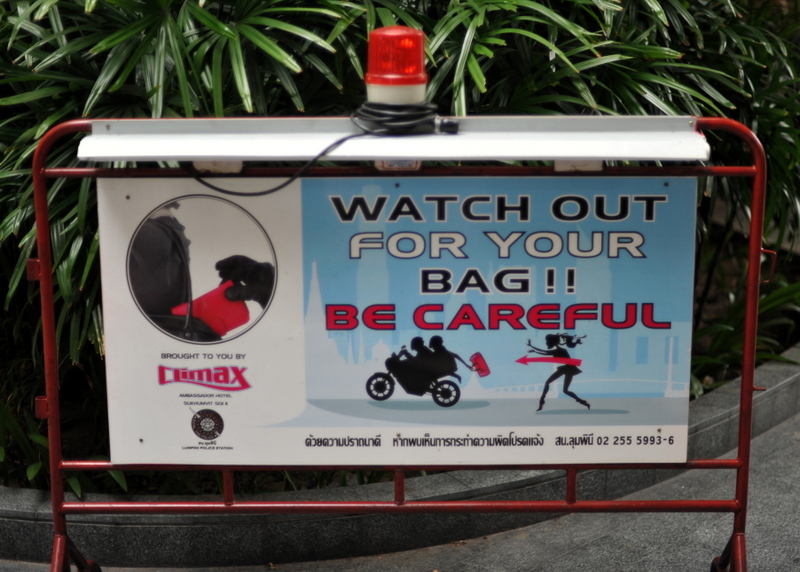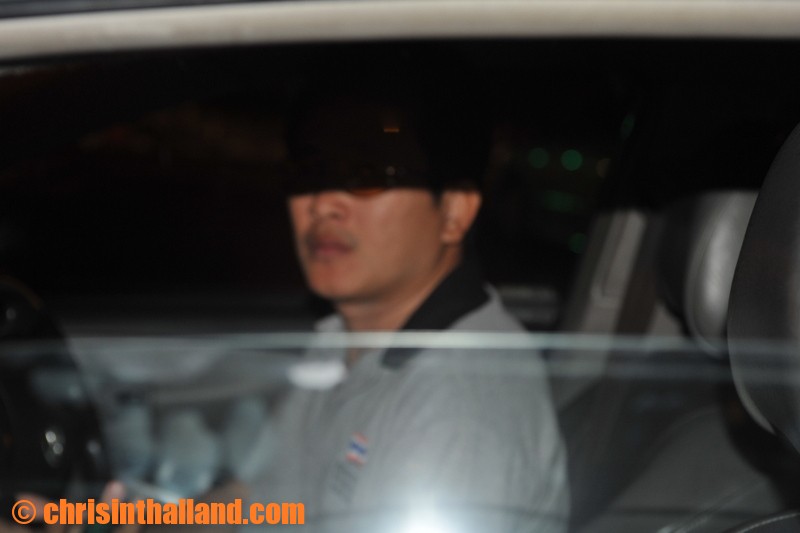Reading a list of scams found in Thailand is probably no one’s idea of fun, but coming to Thailand means being aware of what to watch out for. I’m happy to say that as of yet, I’ve yet to be scammed… badly… (knocks on wood)… It’s thanks to a bit of vigilance, not being visibly drunk in public, and otherwise being skeptical of anyone trying to get friendly in an otherwise ordinary situation. Note that while official assistance may be available – the 1672, 02-134-4077 or 02-356-0650 hotlines are some places to start – but don’t count on them getting you out of a tight situation.
1. Menus that are different in English and Thai
Nice enough – now flip it over:
Apologies for the shakiness – smartphone pictures aren’t always able to deliver a sharp picture when shutter speeds get too low!
In this case, the prices are the same, but the selection is different – and the English side is skewed towards the more expensive choices. The prices are different on the two sides maybe 30-40% of the time in my experience.
HOW TO RESPOND: If you’re not too picky, try the point-and-smile-and-pray approach – and specifically pointing to the Thai side of the menu while making eye contact. Be sure to check the bill to ensure you get charged the Thai price, if there’s a difference.
Alternatively, if your selection is on the English side (at a higher price), flip it over and start looking for it on the Thai side, even if you have no idea how to read Thai. If the waiter is smart they’ll point to the same thing in Thai before you get flustered and just order the cheapest thing possible. If the waiter is obtuse or acts as though there’s no problem, pull out your handy-dandy smartphone (or guidebook or any resource you have with you) to help you figure things out.
2. The Grand Palace’s many scams and schemes
Ah, the Grand Palace. Who doesn’t love a 500 baht entrance fee for visiting one of the country’s most well-known tourist destinations? It is truly remarkable, of course – but that’s beside the point. These get condensed because they’re all basically the same – don’t go there, come with me instead! – though they do come in many forms. The average tuk-tuk driver will likely make more in a single trip with an easy mark than he will the rest of the day, and possibly the week. Whether that’s a kickback or just the card for free gas, that’s coming from somewhere.
2a. The corn pellet scam – to feed the pigeons, naturally. Let’s review here – you’ve come to a foreign country, whether it be for days or years – and you want to feed the pigeons?! There’s a part of me that almost doesn’t feel bad for someone that falls for this scam. Someone comes up to you, offering you a bag of corn pellets or something else to feed the birds. When you’ve thrown it all away, they hit you up with a demand to be paid. Seriously. This isn’t even rocket science, and should look fishy from 50 meters away.
2b. ‘The palace is closed today’, or ‘the palace is closed for an hour’ can legitimately happen – but it’s so rare in reality that it’s quite unlikely to be the case. It’s worth mentioning that the touts out front have one, and only one interest – and that ain’t to help you.
HOW TO RESPOND: Option A: troll! This may not be your personality style, of course, but if it is, have some fun with the guy. Speak Spanish. Or French. Ask why all the tourists are going to that open gate over there, or ask where the TAT (Tourism Authority of Thailand) office is to confirm with them. Make a reference to when you were actually born, because it sure as hell wasn’t yesterday.
Option B: walk on – as you might guess, the entrance to the country’s most popular tourist destination is bound to attract the folks that make their money from the folks that visit. Ignore them, at the very least, and pass on the convivial faces that offer to help in some way.
It should be noted, of course, that the dress code for the Grand Palace is official and legitimate – and that guards with guns enforce it. Cover-ups are rentable if needed, but you’re better off just dressing correct to begin with. From the official tourismthailand.org page:
1. Shorts, mini-skirts, short skirts, tight fitting trousers, as well as tights can not be worn as outer garments.
2. See-through shirts and blouses, as well as culottes or quarter length trousers can not be worn.
3. Sleeveless shirts or vests can not be worn as outer garments.
4. Sandals (without ankle or heel straps) can not be worn.
5. All shirt sleeves, whether long or short, can not be rolled up.
6. Sweat shirts and sweat pants, wind-cheaters, pajamas and fisherman trousers can not be worn.
For guys, wearing jeans, a regular t-shirt (e.g. with sleeves), and tennis shoes looks to be just fine. For girls, wearing a longer dress, a regular t-shirt (e.g. with sleeves), and tennis shoes looks to work.
3. The bag / purse / petty snatchers
This one is warned about along Sukhumvit road, although it seems fairly rare personally. Almost any super-crowded area where there’s lots going on is a great place for a thief to work, and it only takes a split-second to happen.
HOW TO RESPOND: Prevention – keeping a firm grip on your things is one thing, but making them out of sight is even better. Look through your Facebook on your smartphone later – navigating the crowd requires more attention than you think. I don’t want to be your mom here, but not being visibly drunk is a good way to avoid looking like an easy target. Wearing your bag across your shoulder – and having a hand over any open flaps – makes it that much harder to reach inside.
4a. The ‘no meter’ taxi driver
Taxi drivers everywhere have a mostly-deserved reputation, but the ones in Thailand often deserve the name they make themselves. Saying ‘no meter!’ is a surefire way to tell you’re about to get ripped off. Remember that the official flagfall as of now in Bangkok is 35 baht. I wouldn’t want to work for that, but that’s the system. Anecdotally speaking, it’s the touristy destinations – or the places where tourists go to look for taxis – that seem to trigger these particular words in the taxi driver’s vocabulary.
HOW TO RESPOND: BTS (SkyTrain). MRT (Mass Rapid Transit). BRT (Bus rapid Transit). Bus. On foot. Wait for the next one that drives by – any stopped taxi with a driver leaning against his car has no incentive to hop back in for a standard fare.
Go ahead and haggle if you like – or attempt to report a taxi driver at 1584 (a hotline connected to the Land Transport Department) or 1197 (the Traffic Police hotline). Note the license plate (yes, there are Thai letters on it) and the date and time of the incident. A picture of said license plate absolves you from having to rewrite them, but be aware few drivers in the wrong will particularly enjoy having their license plate pictured.
Also note that there are some honest taxi drivers out there, and some legitimate excuses (end of shift, the need to refuel) might be possible.
4b. The airport taxi driver
This guy’s a special breed. For ‘only’ 700 or 1,000 baht (or maybe even more), he’ll take you where you’re going in Bangkok. As you do the mental conversion from your home currency to Thai baht you think ‘I don’t care, I just want to reach my hotel / apartment / second home’ and you load your stuff. You may or may not be told there’s a surcharge for getting picked up from the airport. It’s when you get in the taxi that you’ll be told you have to pay the expressway fare (legitimate). Never mind that the meter would be a fraction of that.
I am happy to report that the Airport Link is new, working, and charges 15-45 baht to connect you to several points in or around Bangkok. Official details are at http://bangkokairporttrain.com/time-table-route.html, and even the ‘Express’ train at 150 baht is a relative bargain. The trains leave every 15-30 minutes, and from the airport you can follow the signs on the first floor to the trains.
4c. The tuk-tuk driver
I’ve yet to hear a story of a tuk-tuk driver asking for a reasonable fee to get from A to B. Trying it once is fine for experience’s sake, but there’s almost always another way to wherever you’re going. Whenever you can see a person’s head begin to calculate how much they can charge, that’s not meant to help your wallet.
HOW TO RESPOND: BTS (SkyTrain). MRT (Mass Rapid Transit). BRT (Bus rapid Transit). Bus. On foot. I’m not sure if the aforementioned hotlines accept complaints about tuk-tuks, since they’re not metered and have no official system regarding payment.
5. The tour group scam
This one, while not always / necessarily a scam, isn’t needed. Even in the best-case scenario, you’re paying for the convenience to reach someplace you could likely get to with public transportation – and you’re marked as a tourist from the moment you get off the bus. This isn’t just the buses that leave from Khao San Road, although you can safely assume they’re well overpriced.
HOW TO RESPOND: Get there on your own. Bangkok’s own bus terminals, while not necessarily the easiest to navigate, can be figured out.
And a bonus one: a reminder that change is something to believe in – and count. Do the math in your head, watch the register’s screen (or the receipt), then count your coins. It’s very nearly happened to me – I was once given a large number of 20 baht bills from a grocery store as change, and the cashier made a rather poor attempt at counting them. It was clearly a mistake, and they rectified it instantly – a reminder that even an unintentional non-scam can cost you money.
Pro Tip – A great way to stay safe is by staying at hostels. The staff are always friendly and will point you in the right direction. Check out our list of the top hostels in Chiang Mai, or the coolest hostels in Bangkok!
Like this post? Like the Facebook page!




